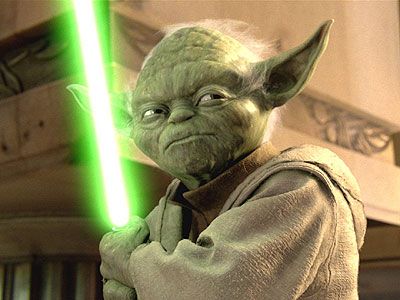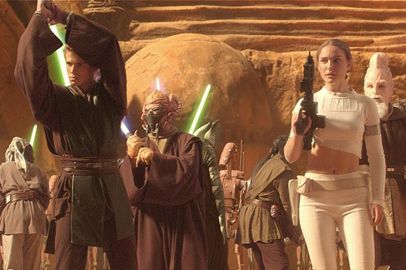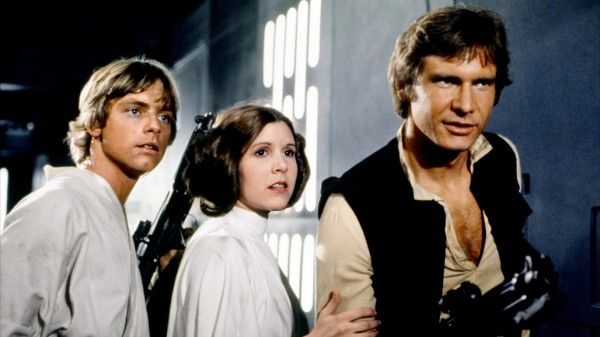Everybody knows the name George Lucas. Whether you love or hate the guy, his name is instantly recognizable and sends off the first few notes of John Williams’ Star Wars score in your head. Another name you may or may not know is Rick McCallum. McCallum’s relationship with Lucas began on the early 1990s TV series The Young Indiana Jones Chronicles, after which Lucas tapped McCallum to produce the three Star Wars prequels. Steve recently talked with McCallum to discuss the World War II action-adventure pic Red Tails (which Lucas and McCallum produced), and while we’ll have the full interview up closer to the film’s release, we wanted to share a few tidbits with you today.McCallum talked at length about the long-in-the-works live-action Star Wars TV series, discussing the show’s tone, the logistics of doing an effects-heavy series on television, how soon the show might come to fruition, and a lot more. Hit the jump to see what he had to say.The budget issues on the live-action TV series (working title Star Wars: Underworld) are well-documented. The difficulty of getting great-looking visual effects done on a television budget is the chief sticking point standing in the way of production:
“This is the best way to put it into perspective: we did Episode III—which is one of the larger of all the Star Wars films in relation to set construction, visual effects, the amount of visual effects and everything else—and that was made for $100 million which was unheard of even five years ago, because had it been made by any studio or anywhere in the United States it would have been easily double that price. So imagine an hour’s episode with more digital animation and more visual effects and more complicated in terms of set design and costume design than a two-hour movie that takes us three years to make, and we have to do that every week and we only have $5 million to do it. That’s our challenge.â€
So how close are they to overcoming the challenge? Let’s just say don’t expect to see Star Wars on any network schedules this fall:
“It’s not a challenge that I think can be dealt with in the next year or two years, I think it’s gonna be a little bit more longer term goal.â€
McCallum said that one of the most expensive aspects of the series is the CG characters:
“[George has] come up with so many extraordinary digital characters that are onscreen for 30-40 minutes. Most people who love movies and kind of understand the process realize that if you do a character like Gollum or Jar Jar or any major digital character, that costs twice as much as having Tom Cruise in a movie. You get 150 people working for two years on a 40 minute performance and they all make serious money, you just add it up; that’s gonna be a serious $20-30 million character. That’s our problem, how do we get that down?"
The producer went on to lay out the other specific issues they’re trying to overcome, including the overwhelming number of virtual sets that are needed:
“[With] digital 3D matte paintings, how do we cut the time from 2-3 weeks to 2-3 days? On a television budget, on television screens it doesn’t have to be film res, but each one of these are major challenges for us. How do we get virtual set software? Because we can’t build any of this stuff. I mean we could do it if we did it in a traditional format where we have one set with all the characters, but George doesn’t work that way. We have 40-50 set pieces per hour, every minute and a half to two minutes there’s another set. Well we can’t build that and do that every week, that’s virtually impossible, so we have to come up with virtual set software and an environment that allows us to be able to do that on blue and green screen and be able to turn those backgrounds around really, really fast. We’re getting there, but it’s not perfect yet and it’s still too expensive.â€
While production is still a ways off, over 50 scripts have already been banked for the show once it gets the go-ahead. Regarding the tone, McCallum revealed that it’s actually quite a bit darker than the film series:
“It’s much darker [than the movies]. It’s a much more adult series. I think, thematically, in terms of characters and what they go through, it will be…if we can ever get it together and George really wants to pursue it, it’ll be the most awesome part of the whole franchise, personally…It’s Empire Strikes Back on steroids.â€
McCallum said that they originally envisioned the series as “Deadwood in space,†so it’s easy to see where that darker tone comes from. The producer elaborated on the Deadwood comparison, conceding that we won’t necessarily see any Jedi throwing around the word “fuckâ€:
“Obviously, we changed it for where we couldn’t go in terms of language. It was to be serious performances, very complicated relationships, unbelievable issues of power and corruption, greed, vanity, pride, ego manifesting itself at levels that only equal the world that we live in now, but, as I said, on steroids.â€
So while we’ll have to wait quite a while for the live-action Star Wars series, it certainly sounds like it’ll be one of the most ambitious feats of TV storytelling ever attempted. Keep an eye out for Steve’s full interview with McCallum which is chock-full of information on Red Tails, the future of visual effects, and George Lucas’ filmmaking plans in the years ahead.




